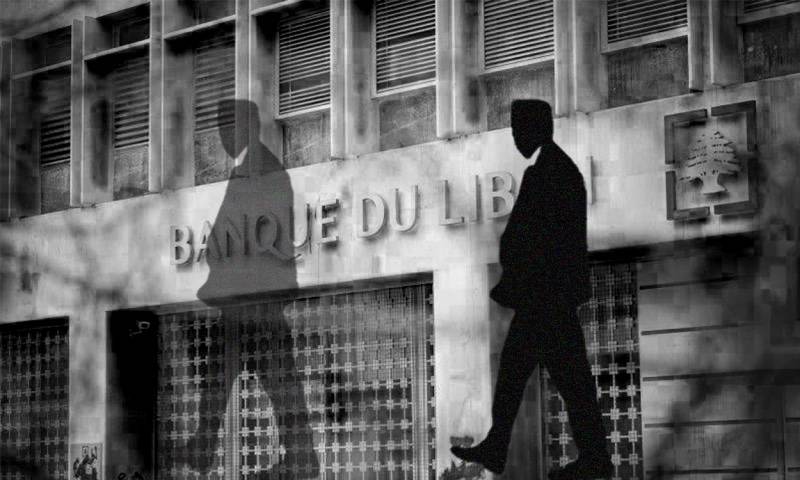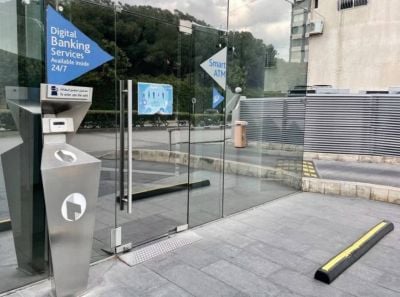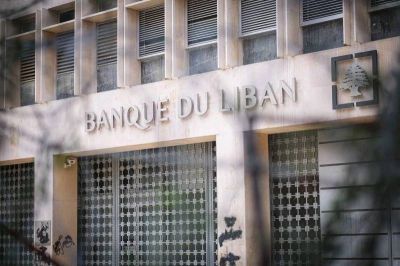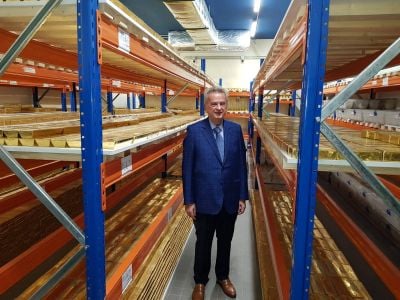
After 30 years of reign, the governor of Banque du Liban will step down on July 31. (Illustration: Guilhem Dorandeu)
When Banque du Liban (BDL) Governor Riad Salameh steps down on July 31, he will leave behind a heavy legacy after 30 years in office, amid a tense political, economic and financial context.
Whoever his successor may be — even if the post temporarily goes to his first deputy Wassim Mansouri on an interim basis — they will have to assume a task that has been expanded well beyond monetary policy and financial regulation during Salameh’s five terms in office. In particular, they will be closely scrutinized on six key issues — decisions on these issues will reveal whether Salameh’s path is being extended or if there is to be a change of course in BDL’s policymaking.
Exchange rate unification and the future of Sayrafa
The lira’s stability is one of BDL’s governor’s traditional missions and undoubtedly a symbol of Salameh’s long reign — well, up until the financial crisis derailed everything. Stabilized for decades, the exchange rate against the US dollar started to falter in 2019, to the point where it has now lost almost 98 percent of its value.
Yet, the fact that authorities maintained an official rate has contributed to the emergence of multiple exchange rates: the official rate (LL1,507.5 to the dollar; revised to LL15,000 on Feb. 1, 2023), the parallel market rate and the many intermediate rates — including the ‘lollar’ rate or bank dollars — which BDL’s circulars introduced to allow the withdrawal of part of the deposits held in the bank.
This incongruity is constantly being denounced by international institutions, including the International Monetary Fund — from which Lebanon is still trying to obtain $3 billion in financial aid. The IMF insists that it is necessary for Lebanon to unify the exchange rates to restore confidence and reduce pressure on BDL’s foreign currency reserves.
Salameh has been pursuing the same objective since the early months of the crisis. In late June 2020, he officially set up the Sayrafa platform with the aim of controlling foreign exchange transactions and stabilize fluctuations on the parallel market.
While the platform initially struggled to demonstrate its effectiveness, and BDL’s massive interventions failed to permanently halt exchange rate volatility on the parallel market rate — which climbed as high as LL140,000 to the dollar at the end of March — the latest intervention seems to have brought relative stability, with the rate hovering around LL91,000 in recent weeks.
On the other hand, the Sayrafa rate is still significantly lower than the parallel market rate — around LL85,500 to the dollar in recent days — and has failed to establish itself as the benchmark.
To finance its operations, BDL first drew on its foreign currency reserves. Then, when the reserves hit an alarming level, BDL started printing and selling lira on the parallel market, before reinjecting the currency obtained on its platform. This mechanism, which relies in particular on a network of cooperative money changers, has increased the exchange rate volatility and exacerbated inflation — the opposite of the stated objective.
Sayrafa has been subjected to much criticism for its lack of transparency and broadened scope. For example, since the introduction of Circular No. 161 in late 2021, which allowed depositors to buy dollars at the Sayrafa rate, which is more favorable than the parallel market rate, the platform has de facto played two other roles.
On the one hand, it has served as a tool to support the purchasing power of the Lebanese who benefit from it [including civil servants whose salaries have been subsidized through this tool since last January].
On the other hand, it has served as a speculation tool for agents who trade between the discounted rate on the Sayrafa platform and that on the parallel market— with nearly $2.5 billion in arbitrage profits earned on Sayrafa, according to the World Bank.
The future of this platform will depend “to a large extent on the resources available to the governor and his willingness to restrict Sayrafa’s role to that of an exchange rate policy tool, abandoning the monetary or fiscal policy related roles,” economist Patrick Mardini told L’Orient-Le Jour.
Will BDL’s next governor follow this path or comply with the IMF’s orders by adopting a foreign exchange platform that shows the volumes and amounts of the transactions and BDL’s interventions with full transparency?
According to Mardini, there is only one thing we can be sure of: halting intervention on this platform overnight “without halting the financing of the state, will probably cause the exchange rate to depreciate sharply.”
The use of foreign reserves
Another thorny issue for the new governor is how to deal with BDL’s dwindling foreign reserves. At the start of the crisis, these reserves stood at $33 billion, but they have steadily declined, and reached $9.6 billion, according to the BDL’s latest fortnightly balance sheet.
This fall was mainly due to the efforts to stabilize the lira value by injecting foreign currency into the market, reimbursing a part of bank deposits and subsidizing certain imports, notably fuel, and certain medicines and foodstuffs, which has since been largely abandoned.
The fact that is even more worrying is that the level and availability of these foreign currencies are also open to question, as the transparency of BDL’s accounts remains contested.
As a result, “the new governor’s mission should be to stop squandering the little foreign currency left and to try to increase its level so as to have greater room for maneuver. In other words, he must learn to say no to the government and to the subsidization of the civil servants’ salaries,” said Mardini.
To achieve this goal, monetary stability needs to be ensured and the banking system needs to get back on its feet so as to use the interest rates to attract capital.
Gold stocks
The question of using Lebanon’s gold stock to replenish its foreign exchange reserves has been raised on several occasions. According to official figures, Lebanon currently has 286 tons of gold, valued at around $17.75 billion, according to BDL’s latest balance sheet.
But in order to sell this stock, or part of it, it is necessary for Parliament to approve the sale through the enactment of a law. This safeguard was put in place by MPs in 1986, against the backdrop at that time of very sharp lira depreciation.
As with foreign currency reserves, the lack of transparency is once again raising doubts about the real level of gold stocks. Faced with this situation, BDL announced in late November 2022 that it had “successfully” completed an audit of its gold reserves via a “specialized” international company. However, this announcement did not successfully dispel suspicions.
Nevertheless, the governor’s options in this respect are very limited: apart from the need for a law, selling the gold, or part of it, in a context where the public authorities have not undertaken any reforms would probably provoke outcry from the Lebanese population.
Capital control
Another issue on which Lebanon and the governor will be scrutinized is the introduction of capital controls to officially hinder the free movement of capital between Lebanon and other countries — the time to balance the balance of payment. This is the solution adopted by nearly every country facing a similar situation.
“Riad Salameh should have immediately imposed capital controls, as his Cypriot and Russian counterparts did, for example, to avoid a rush to banks,” said tax lawyer Karim Daher, who helped draft two bills on the restructuring of the banking sector and capital controls, drawn up by the Beirut Bar Association and presented to Parliament by the Forces of Change bloc MPs.
However, while the current governor and the Association of Banks in Liban (ABL) have consistently argued in favor of such a law, the informal restrictions the banks imposed in the first weeks of the crisis — which BDL circulars, intended to be temporary, have legitimized — continue to play this role.
A draft law in this regard, which is different from that of the Bar Association, was finalized in January, but was not adopted by Parliament during the plenary meeting. However, it is less in line with the IMF’s requirements than the version the cabinet finalized in March 2022.
But given the durability of these illegal restrictions, will the adoption of official capital controls be one of the new governor’s priorities? According to almost all observers, this remains a necessity insofar as it is one of the IMF’s preconditions for unlocking financial support. The move would also give legal cover to the banks, particularly in the context of lawsuits brought against them abroad, and help to provide greater transparency and stability in the long term.
Bank restructuring
The adoption of legal capital controls is above all a prerequisite for another issue, this time directly in the hands of the new governor: the restructuring of a banking sector that has been failing and short of liquidity since the start of the crisis. The sector’s restructuring, which is among the reforms demanded by the World Bank and IMF since 2020, aims to relaunch banking activity on a sound footing, and should be based in part on an audit of all the banks in Lebanon, including the 14 largest ones.
For Lebanon’s partners, led by the IMF, the objective is to recapitalize the viable banks and let the others disappear, and to distribute — fairly, if possible — the losses incurred by the various parties, from shareholders to depositors. This is undoubtedly the crux of the problem: at a time when Lebanese banks have effectively ceased to operate normally, preventing any possibility of financing the economy, ABL has done everything in its power to impede this process and thwart the various government plans (then-Prime Minister Hassan Diab’s plan in 2020, then that of Deputy Prime Minister Saade Chami since mid-2022), which were more favorable to small depositors.
In this battle, the banks found a powerful ally: “The governor should have played a much more active and rapid role in this process,” Daher said.
As a result, four years after the outbreak of the crisis, bank restructuring is still being negotiated between the government, BDL, the Banking Control Commission (BCC) and the IMF, even though no text has yet been sent to MPs.
In addition, the draft on capital controls and deposit withdrawal limits “requires considerable revisions to effectively support the banking sector restructuring strategy,” according to the IMF.
Governance within BDL
Finally, the last major challenge of this new phase is the launch of governance reforms within BDL itself. This is a necessity according to the vast majority of observers, NGOs and international partners, in order to turn the page on Salameh’s era.
In an article published in L’Orient-Le Jour, Henri Chaoul, a former member of the Lebanese team negotiating with the IMF, draws up a list of the reforms that are needed in this area, particularly with regard to the independence of the main regulatory bodies under Salameh’s authority: from the BCC to the Special Investigation Commission (SIC), and the Capital Markets Authority (CMA). This change must also involve tightening the requirements and procedures for appointing and dismissing staff, while eliminating political interference in this process.
As Daher put it, “The new governor needs to get the skeletons out of the closets.”
This article was originally published in French in L'Orient-Le Jour. Translation by Joelle El Khoury.


